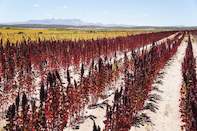Quinoa (Chenopodium quinoa Willd.) - pronounced as ‘keen-wah’ - is a protein-rich (12 - 16.5%) flowering plant producing edible seeds with a delicate, almost nutty taste. Although its seeds are not produced by a grass like wheat, for example, it is considered a ‘pseudo-grain’ because of the use of its grain-like seeds.

World Production of Quinoa
Quinoa is cooked the same way as rice and can be used in dishes such as breakfast porridges, as filling for wraps, in soup, salads and as a risotto.
Quinoa is indigenous to countries in the region of the Andes Mountains in South America, from Colombia to the north of Argentina and the south of Chile. Quinoa output in native production areas showed an increase of 32,4% and 27,5% in Peru and Bolivia respectively between 2008 and 2012.
In 2013 it was declared International Crop of the Year by the United Nations and thereafter global production boomed. Quinoa production rapidly increased especially in countries where it was most recently introduced, such as China where quinoa is mostly produced for local consumption.
Quinoa is also commercially produced in countries in Europe (e.g. France, Italy, the UK, Sweden), Africa (Kenya and Zambia), Asia (India) and in Canada. The main quinoa-producing countries are Bolivia, Peru and the United States.
Quinoa Production in South Africa
No uniform variety of quinoa has been developed and none is registered in South Africa. The crop is undergoing pest-risk analysis to determine its impact on other crops and the environment. In addition, chemical crop protection sprays need to be registered while hybridisation trials are conducted to develop a hot-weather tolerant cultivar.
William Weeks, an agricultural scientist at the North-West Department of Agriculture and Rural Development believes in the potential of quinoa in South Africa. Areas like the Cape’s west coast and Lesotho may be appropriate, provided we have a suitable cultivar for the warm and dry South African conditions. Quinoa is a cool-weather crop with certain quirks such as germination while still on the plant when rain falls on the ripe seed plumes. This explains the need to find the correct seed-climate combination to allow for commercially viable yields.
Quinoa can diversify the crop range of local farmers and will be a suitable candidate for dryland production, but a suitable market and processing technologies need to be in place before commercial production with suitable quinoa cultivars starts, he cautioned. Quinoa research in South Africa is coordinated by the NuGrain Consortium.
The NuGrain Consortium, was established in 2010 for the development and research of amaranth, a related crop. Since then, NuGrain focusses on new crops that require research and development, such as amaranth and quinoa. Their motto ‘Food security through diversity’ indicates the aim to diversify the crop base in South Africa, considered one of the countries that depends on the narrowest crop range for its food security.
By Marinda Louw